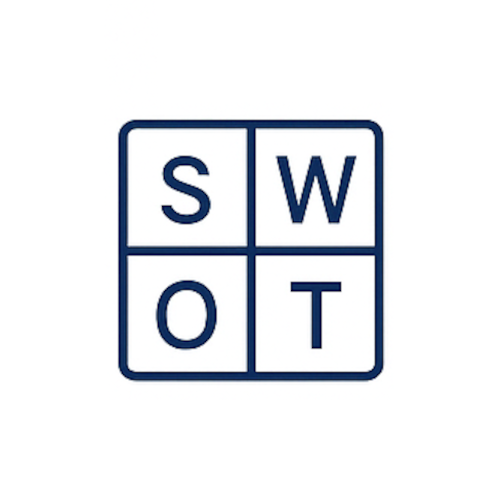In our day-to-day business language, we frequently encounter various terms, yet their usage and understanding are not always accurate. Common mistakes include using terms interchangeably or relying on assumptions about their meanings. This can lead to miscommunication and misunderstanding within an organization, so gaining a solid understanding of these key concepts is not just beneficial; it is fundamental for effective communication and strategic decision-making. So, let’s walk through this comprehensive glossary of key business terms.
Benchmarking: Comparing an organization’s processes, products, or performance metrics against industry standards or best practices to identify areas for improvement.
Business Model: A business model outlines how a company creates, delivers, and captures value. It describes the fundamental aspects of a business, including its revenue streams, customer segments, and cost structure.
Business Model Canvas: The Business Model Canvas is a visual framework that outlines the key components of a business model. It includes nine segments such as customer segments, value propositions, channels, customer relationships, revenue streams, key resources, key activities, key partnerships, and cost structure.
Competitive Analysis: Competitive analysis involves assessing the strengths and weaknesses of competitors to inform strategic decision-making. It helps businesses understand market dynamics and identify opportunities for differentiation.
Competitor: A competitor is an entity, such as a company or business, that operates within the same industry or market and offers similar products or services. Competitors vie for the attention of the same target audience, often leading to rivalry as each seeks to gain a competitive advantage in terms of market share, customer loyalty, and overall industry standing.
Core Competency: A unique capability or set of skills that gives a business a competitive advantage and distinguishes it from competitors.
Goal: A goal is a broad, overarching outcome an organization aims to achieve. Goals provide a sense of direction and purpose, guiding the strategic initiatives of the business.
Initiative: Initiatives are strategic actions or projects undertaken to achieve specific objectives. These can be short-term or long-term efforts aligned with the overall strategic approach.
KPI (Key Performance Indicator): KPIs are specific metrics that are deemed critical to the success of an organization. They serve as benchmarks for evaluating performance and progress toward strategic goals. KPIs help businesses focus on the most important aspects of their operations, ensuring alignment with overall objectives.
Market Segmentation: Market segmentation is the process of dividing a market into distinct groups of customers with similar needs, characteristics, or behaviors. It allows companies to tailor their marketing strategies to specific segments.
Market Share: Market share represents the percentage of total sales in a market that a company holds. It is a measure of a company’s relative strength in a particular industry.
Metric: A metric is a quantifiable measurement used to track and assess the status, performance, or progress of a particular aspect of a business. Metrics provide objective data that can be analyzed to make informed decisions and evaluate the effectiveness of strategies.
Mission: The mission of a business encapsulates its fundamental purpose, defining why the organization exists and the core values guiding its operations.
Objective: Objectives are specific, measurable steps taken to achieve a goal. They are the actionable components that, when accomplished, contribute to the acomplishment of broader organizational goals.
Organizational Culture: Organizational culture encompasses the shared values, beliefs, and behaviors that shape the work environment within a company. It influences how employees interact and make decisions.
Risk: In the business context, risk refers to the potential for adverse outcomes that may hinder the achievement of organizational goals. Effective risk management involves identifying, assessing, and mitigating potential threats.
Risk Management: Risk Management involves identifying, assessing, and mitigating risks that may impact the achievement of organizational objectives. It aims to minimize negative impacts and seize opportunities.
ROI (Return on Investment): A measure of the profitability of an investment, calculated as the ratio of the net gain or loss to the initial investment cost.
Scalability: The ability of a business or system to handle growth or increased demand without compromising performance or functionality.
Stakeholders: Stakeholders include a broader range of individuals or groups who have an interest in the company and can be affected by its actions and decisions. This may include employees, customers, suppliers, the local community, government entities, and more. Their interests can extend beyond financial concerns and may involve aspects such as environmental impact, social responsibility, and the overall reputation of the company. Stakeholders can influence and be influenced by the company, even if they don’t necessarily own shares in it.
Shareholders: Shareholders are a specific type of stakeholder who have a financial interest in the company. They own shares of the company’s stock, which represents ownership in the business. Shareholders are primarily concerned with the company’s financial performance and the return on their investment. Their relationship with the company is often defined by their financial stake and voting rights in certain matters.
Strategic Approach: The strategic approach is the overarching method an organization employs to achieve its goals. It involves a combination of tactics, policies, and decisions designed to align with the mission and vision.
- Blue Ocean Strategy:
- This is a strategic approach that focuses on creating uncontested market spaces by innovating and introducing products or services with unique attributes.
- The term “blue ocean” metaphorically represents a market space where competition is minimal or non-existent, allowing a company to create and capture new demand.
- This strategy encourages businesses to move away from crowded and competitive “red ocean” markets to explore untapped opportunities, emphasizing innovation and differentiation.
- Red Ocean Strategy:
- Red Ocean Strategy is the traditional competitive approach where businesses compete in existing markets, striving to outperform rivals and gain a larger share of the existing demand.
- The term “red ocean” symbolizes the fierce competition in established markets where companies battle for the same customers, leading to market saturation and often reduced profitability.
- In a red ocean scenario, the focus is on incremental improvements, cost-cutting, and gaining a competitive advantage within the existing market structure.
Strategic Decision-Making: Strategic Decision-Making is the process of choosing among alternative courses of action to achieve long-term goals and objectives. It involves considering the organization’s mission, vision, and overall strategy.
Strategic Driver: Strategic drivers are key concerns that significantly impact an organization’s success, such as profit, market share, and revenue. Identifying and focusing on these drivers is integral to strategic planning.
Strategic Fit: Strategic fit refers to the alignment between a company’s strategy and its internal capabilities and external environment. It ensures that the organization’s activities are consistent with its overall strategic direction.
Strategic Pillar: Strategic pillars are high-level areas of focus crucial for achieving an organization’s vision. These pillars serve as foundational elements, guiding the allocation of resources and efforts.
Strategic Profile: A strategic profile is a comprehensive overview of an organization’s strategic positioning within its industry. It encompasses the company’s mission, vision, goals, and key strategies, offering a snapshot of its competitive advantages and distinctive features. This profile serves as a strategic reference point, providing insights into how the organization differentiates itself and aligns its resources to achieve long-term success.
Strategic Roadmap: A strategic roadmap is a visual and detailed plan that outlines the strategic goals, initiatives, and milestones of an organization over a specific period. It provides a clear, high-level overview of the strategic direction, helping stakeholders understand the steps needed to achieve the desired outcomes. A strategic roadmap typically includes key initiatives, timelines, dependencies, and critical success factors, offering a dynamic guide for effective communication and execution of the organization’s strategic vision.
Strategy: Strategy is a high-level plan or approach designed to achieve specific goals or objectives. It involves making choices on allocating resources, setting priorities, and determining actions to reach desired outcomes. Strategy is the overall guiding framework for an organization.
Value Chain: The Value Chain is a concept that describes the sequence of activities a company performs to design, produce, market, deliver, and support its products or services. It highlights the value-added at each stage.
Value Proposition: A Value Proposition is a statement that communicates the unique benefits a product or service offers to customers. It answers the question, “Why should customers choose our offering?”
Vision: A vision is a forward-looking statement that articulates where the organization aspires to be in the future.
In summary, a clear understanding of these essential business terms provides professionals with a valuable resource for effective communication and informed decision-making within an organization. This comprehensive glossary acts as a reference, encouraging a common understanding among business professionals and reducing the risk of miscommunication.












